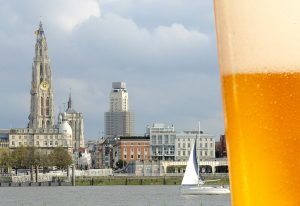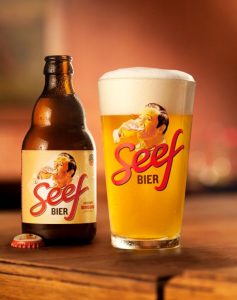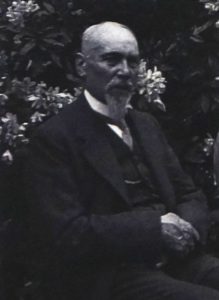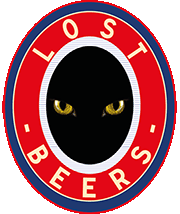A recipe for Antwerp seef
 And now a legendary beer from Antwerp: seef. But, the city beer of Antwerp, that would have to be De Koninck? It may be now, but in fact this amber-coloured ‘spéciale belge’ only began its rise in the 1930s.[1] No, before that there was a beer called ‘seef’ (pronounced ‘safe’), a beer type so popular that an entire district of the city was named after it. Since a few years, this beer is back on the market again, which is of course a great initiative. So, today we will look at the question: what was seef exactly? Including a historic recipe with notes on yeast types, turbidity and grains like oats, buckwheat and rye.
And now a legendary beer from Antwerp: seef. But, the city beer of Antwerp, that would have to be De Koninck? It may be now, but in fact this amber-coloured ‘spéciale belge’ only began its rise in the 1930s.[1] No, before that there was a beer called ‘seef’ (pronounced ‘safe’), a beer type so popular that an entire district of the city was named after it. Since a few years, this beer is back on the market again, which is of course a great initiative. So, today we will look at the question: what was seef exactly? Including a historic recipe with notes on yeast types, turbidity and grains like oats, buckwheat and rye.
If sometimes I complain about the flawed beer historiography of Belgium, there certainly is nothing to complain about Antwerp. For over a decade a passionate group of people is actively researching the beer history of this port city on the Schelde river. Ivan Derycke is one of them. Their work has, among other things, resulted in four voluminous books with all information you could wish for.[2] (This doesn’t mean that outside Antwerp there is no good beer historiography in Belgium; for instance, a lot of good work is done in the Westhoek region. Unfortunately, the rather unimaginative ‘Gambrinus was duke John of Brabant‘-type books seem to dominate…)[3]
 One of the beers of which the history needed to be researched, was seef. A beer that in Antwerp has a magic ring to it: once, the whole of the city must have drunk it. The 19th century working class district of Seefhoek (literally, ‘seef corner’) was named after it. But what was it? Oddly, 19th century literature didn’t consider seef as the typical Antwerp beer. Beer writers like Vrancken and Lacambre prefer to mention Antwerp’s gerste (‘barley’) beer, which clearly was something else.[4]
One of the beers of which the history needed to be researched, was seef. A beer that in Antwerp has a magic ring to it: once, the whole of the city must have drunk it. The 19th century working class district of Seefhoek (literally, ‘seef corner’) was named after it. But what was it? Oddly, 19th century literature didn’t consider seef as the typical Antwerp beer. Beer writers like Vrancken and Lacambre prefer to mention Antwerp’s gerste (‘barley’) beer, which clearly was something else.[4]
At the time gerste was a relatively new beer type in Belgium. All over the Low Countries, all-barley beer only became common around the year 1800. The barley beer of Antwerp was available in various strengths, a result of mixing the first and later runnings from the same grist. At a brewery like De Koninck, the ‘extra gerste’ made up 60 to 70% of production in the early 20th century. Their amber-coloured spéciale became popular only in the late 1930s.[5]
So what about seef? Ivan Derycke and his companions were quite surprised to find out that seef actually had been a typical countryside beer. Not only did Antwerp have a Seefhoek, but surrounding villages like Brasschaat, Herentals, Hoboken and Wilrijk had one too. Moreover, the Seefhoek district that came into being in Antwerp around the year 1860, was largely populated by people who had come from the countryside. You would almost think that these ‘peasants’ had taken their seef with them to the city…[6]
In any case, seef was a white beer, that next to barley and wheat also contained buckwheat and oats. As such, it’s hard to distinguish it from Antwerp’s white beer, that does get mentioned in 19th century sources, even though it’s not called ‘seef’ there. This white beer was the old beer of Antwerp before gerste became popular.[7] And yes, in this multi-grain white beer we can recognise the old white beer of Brabant as a whole, which was brewed in places like Leuven and Hoegaarden, but which I also found in Etten in the Netherlands, with an impressive amount of buckwheat in it. As a ‘Brabands’ white beer I found it as far north as Haarlem.
 All in all seef, which may have been the same thing as Antwerp white beer, must have disappeared somewhere during the First World War, or shortly after. Antwerp continued to drink gerste and then switched to the De Koninck, of which the famous ‘bolleke’ glass was only introduced in 1952.[8] Seef was however not forgotten completely, and a few years ago this tickled the imagination of Johan Van Dyck, then a marketeer at Duvel Moortgat brewery. His mission: to revive the old seef beer. Allegedly, after three years of searching, he discovered some documents from an old brewery, and there he found the long lost recipe.
All in all seef, which may have been the same thing as Antwerp white beer, must have disappeared somewhere during the First World War, or shortly after. Antwerp continued to drink gerste and then switched to the De Koninck, of which the famous ‘bolleke’ glass was only introduced in 1952.[8] Seef was however not forgotten completely, and a few years ago this tickled the imagination of Johan Van Dyck, then a marketeer at Duvel Moortgat brewery. His mission: to revive the old seef beer. Allegedly, after three years of searching, he discovered some documents from an old brewery, and there he found the long lost recipe.
An old sample of Antwerp brewing yeast was retrieved at Leuven university, and thus for the first time in almost a hundred years the seef could be brewed again: an unfiltered multi-grain beer with malted and unmalted buckwheat, oats, wheat and barley. It was only the first step of a daring plan: Van Dyck and his wife quit their jobs and invested all their savings in the new Seef, now written with a capital letter as a registered trade mark. Initially brewed elsewhere, it was introduced in 2012 and became an instant hit in Antwerp and beyond. In 2017 they opened their own brewery with tasting room. Antwerp had its seef back! And the result is very much worth a taste.[9]
 A wonderful initiative, because beer history is at its best when you can also drink it. That said, the three years that it took Johan Van Dyck to find a recipe, raised some questions with me. What happens to be the case? In 1916, brewing engineer Hendrik Verlinden (who would later be an advisor to the Westmalle trappist monks and thus be at the origin of their current beers) wrote down a perfectly usable recipe for seef in his book Praktisch handboek der gisting-industrie (‘Practical guide to fermentation industry’). A ‘turbid white beer’ for which he neatly related malting methods, grist, mashing temperatures, original gravity, alcohol content, yeast type, colour and taste of the final product.[10] It took me less than half a day (taking the train to Antwerp, walking from the station to the Hendrik Conscience Heritage Library, ordering the book) to retrieve this seef recipe. I’ll hazard a guess that this is where Johan started too. So why was this recipe not good enough? Sure, in his book Verlinden complained how seef brewers anxiously kept their methods to themselves, and so one could assume that because of this secrecy Verlinden missed out on some very essential information. But did he really?
A wonderful initiative, because beer history is at its best when you can also drink it. That said, the three years that it took Johan Van Dyck to find a recipe, raised some questions with me. What happens to be the case? In 1916, brewing engineer Hendrik Verlinden (who would later be an advisor to the Westmalle trappist monks and thus be at the origin of their current beers) wrote down a perfectly usable recipe for seef in his book Praktisch handboek der gisting-industrie (‘Practical guide to fermentation industry’). A ‘turbid white beer’ for which he neatly related malting methods, grist, mashing temperatures, original gravity, alcohol content, yeast type, colour and taste of the final product.[10] It took me less than half a day (taking the train to Antwerp, walking from the station to the Hendrik Conscience Heritage Library, ordering the book) to retrieve this seef recipe. I’ll hazard a guess that this is where Johan started too. So why was this recipe not good enough? Sure, in his book Verlinden complained how seef brewers anxiously kept their methods to themselves, and so one could assume that because of this secrecy Verlinden missed out on some very essential information. But did he really?
For a moment I contemplated whether Johan Van Dyck, who is a marketeer after all, wasn’t fooling everyone with his alleged three years of searching. But that would be overlooking his enthusiasm for Antwerp beer history. Not only did he visit all former brewery locations of the city on the Schelde, he also contacted local historical associations, telephoned descendants of brewing families, or simply showed up on their doorstep. And only then he found what he was looking for: as it turned out, one family still disposed of historical material, including a complete recipe for seef.[11] You can’t fake such a search and such enthusiasm. So just what is missing from Verlinden’s 1916 recipe?
Of course I asked those involved. Johan Van Dyck was so kind to shed some light on this via e-mail: as far as he’s concerned Verlinden did give advice for brewing white beers, but only based on assumptions. Moreover, according to Van Dyck, Verlinden wanted to modernise the ‘old-fashioned’ methods used by seef brewers, which had an impact on its taste. Van Dyck says that ‘a few crucial things are missing, which is why this isn’t seef… He didn’t have the real recipe.’ Instead, Van Dyck only could get going after finding an ‘actual complete recipe with instructions’, of which the details made an important difference.[12]
I would have liked to tell you what exactly those details were, but Johan prefers to keep this a secret. ‘It’s a question of honouring the traditions of ‘nonsensical’ Antwerp brewers,’ as he puts it himself. Of course I can understand why he wants to keep certain things to himself, after all he did invest all he owned in Seef beer. Which is also why he has registered Seef as a trade mark, to make sure no one else could steal the idea, with dozens of seef beers entering the market. Still, a beer historian like me regrets that, because I do want to know everything.
Anyway, I’ll just tell you what I know, by publishing the apparently-not-quite-correct seef recipe by Hendrik Verlinden. Even if apparently incomplete, it still is a very interesting peek into Belgian brewing methods of 100 years ago. For this beer it was very important that it was turbid, that it didn’t go sour, and that it was made with the right kind of white beer yeast, which apparently was markedly different from the yeast used for barley beer.
Anyway, I cannot guarantee that the result will taste exactly like the Seef that is currently produced in Antwerp, but it does look like a very interesting recipe to try. And please note: you can go and brew beer according to this recipe, but you *cannot* sell it under the name ‘Seef’. As I said, it is now a registered trade mark. I guess you could call it ‘Antwerp white beer’.
 The preparation of Antwerp seef. [Source: Verlinden, Praktisch handboek der gisting-industrie, 1916; my translation]
The preparation of Antwerp seef. [Source: Verlinden, Praktisch handboek der gisting-industrie, 1916; my translation]
Although turbid white beer can be prepared in various ways and from various mixtures of materials, it can nevertheless be said rightly that it isn’t easy to obtain a good turbid beer, that still doesn’t go clear after 15 days.
The principle of all methods of preparing seef should be: to obtain as much albumen, albumose and other unwidely crumbling proteins in the beer, while through the use of gum-like substances giving it a viscosity that enables it to retain those substances, preventing them from settling.
Those brewers who prepare their white beer heavy (1.018 to 1.020) and only from grains, can naturally achieve this goal much better than those who only brew it at 1.010 to 1.014 and mix it with 1 to 2 % of sugar after fermentation.
For the latter brewers, adding rye, shoots and yeast is a necessity to obtain and keep a good turbidity. Also, white beer prepared by adding these substances, is entirely agreeable of taste and look.
A turbidity obtained by starch alone does not endure and quickly makes the beer go sour; turbidity acquired by living yeast cells is insufficient and will all but go away when fermentation continues. Having too many living yeast cells in the beer makes it ferment too strongly in bottles, and also makes it go sour quickly. Seef from heavy malt and malt kilned on high temperatures, also ferments much more strongly in bottles than seef from small malt rich in diastase.
Before the beer is bottled, it should be well fermented.
A dust-like or fine distillery yeast will yield a wonderful seef, entirely resembling Leuven beer, but as it develops a large fermentation power and keeps floating in the beer, and because it contains many lactic bacteria, it makes the beer go clear after 6 to 8 days, and also makes it go sour. The latter may however be prevented by keeping the yeast in a diluted sulphuric acid solution for 45 minutes beforehand.
The true seef yeast should also give a high attenuation, though it should be a little flaky and contain no lactic bacteria; the latter will have enough time to develop in the beer in a moderate quantity after the yeast has settled.
The real white beer yeast is to be obtained from a good white beer brewery, or it can be made by having barley beer yeast reproduce in seef wort for a long period of time.
From time to time the yeast should be cleansed from bacteria by soaking it in diluted sulphuric acid and adding fresh barley beer yeast, to give it some new blood. In this way, seef yeast can be kept in very good condition for several years.
It is the buckwheat, malt shoots, but especially the rye and boiled yeast that make the white beer turbid. They give it plenty of protein-like and gum-like substances, through which the beer obtains a good viscosity to keep all floating substances bound in a kind of emulsion. The main point however to obtain many working or clouding substances in the beer is: taking the first running at 48 to 55° Celsius.
It is well known that proteins start coagulating already at 56° C; if one goes above this temperature – as until now people always have done – one loses many useful substances, to great detriment of the white beer’s full-bodiedness and its turbidity.
The more water is used for the first running, the more of the substances mentioned above one can obtain.
As for the malt, let it be said that small, rough-scaled barley yields the best seef malt. One kilns between 20 to 25° Celsius, allows the leaf shoot to go to half its length, and doesn’t finish kilning above 60° C.
Method:
55 % malt.
15 % wheat.
10 % buckwheat.
10 % oats.
5 % rye.
5 % clean malt shoots.
Take the first running, after the mash has stood for one hour at 48 to 54° C.; add water to obtain a temperature of 70° C. and have it saccharify for one hour. Rinse with water at 80 to 85° C.
When the first and second runnings are in the kettle, the temperature is brought to 70 to 75° C., to continue saccharification there. Once all of the wort is united, one adds one kilogram of Aalst hops per 100 litres of wort, and 20 to 40 litres of well-cleaned yeast and boils for one hour.
In summer, one cools the wort at 23° and in winter at 26° C., one adds the necessary quantity of yeast in the fermentation vessel, and puts the wort in barrels of at least 600 litres.
Putting it in large barrels is necessary so that the yeast can be ejected well. White beer that hasn’t ejected all of its yeast, will ferment too much in bottles and will go sour much sooner.
After the beer has ejected its yeast, the remaining yeast is allowed to settle well, the beer is put in delivery barrels and the sweetening agents are added.
One can also use malted oats and even maize to produce white beer. It remains important to take the first running under 55° C. and have the remainder saccharify well at 67 to 70° Celsius.
[1] Ivan Derycke (red.), Antwerpen bierstad. Acht eeuwen biercultuur, Brasschaat 2011, p. 130.
[2] Which are: Derycke, Antwerpen bierstad; Gustaaf Asaert, Paul Daeleman en Ivan Derycke, Bier op transport, Antwerp 2013; Ivan Derycke (red.), Antwerpse brouwerijen in en rond de stad, vroeger en nu, Antwerp 2015; Paul Daeleman, Brouwerspoëzie of biermarketing vroeger en nu, Antwerp 2017.
[3] That doesn’t mean that a book like Antwerpen bierstad is completely free of this type of bogus history writing. For instance, ‘hop professor’ Denis De Keukeleire seems to think it’s necessary to mention the 1516 Bavarian Reinheitsgebot, and to claim it settled the ‘duel between gruit and hop’. Utter nonsense: in the Low Countries, gruit died out before 1450 or thereabouts, Bavaria itself never knew gruit and the decisions made by a Bavarian duke had zero impact on whatever was happening in what is now Belgium. No suprise then, that two pages before that, De Keukeleire manages to drag duke John of Brabant and his supposed connections to the mythical beer king Gambrinus into his narrative. It is quite baffling that this kind of historical bollocks has ended up in this book. It stands out like a sore thumb next to for instance the well-funded article by Erik Aerts, which follows it.
[4] Jean Baptiste Vrancken, ‘Antwoord op vraag 81’, in: Nieuwe verhandelingen van het Bataafsch Genootschap der Proefondervindelijke Wijsbegeerte te Rotterdam, Rotterdam 1829, p. 203-206; Georges Lacambre, Traité complet de la fabrication de bières et de la distillation des grains, pommes de terre, vins, betteraves, mélasses, etc., Brussel 1851, p. 303-305.
[5] Derycke, Antwerpen bierstad, p. 81-82, 130.
[6] Derycke, Antwerpen bierstad, p. 125-126.
[7] Vgl. Vrancken, ‘Antwoord’, p. 203.
[8] Jef Van den Steen, Speciale Belge Ale. Traditiebier van hier, Tielt 2016, p. 116.
[9] Derycke, Antwerpse brouwerijen, p. 190-192.
[10] Hendrik Verlinden, Praktisch handboek der gisting-industries, deel 2, Brecht 1916, p. 131-137.
[11] https://rubenaerts.com/portfolio/johan-van-dyck-seefbier-antwerpen-duvel-moortgat-marketeer-trends/
[12] Information courtesy of Ivan Derycke, Paul Daelemans, Johan van Dyck, mei 2018.






This is very interesting Roel, as always. This is the first time I read about boiling part of the yeast. What do you know about it? Is it to be used as nutrients? Do you know if it was a common practice?
This is the first time I have heard about boiling the yeast too!
Very different.
Does somebody have more info abou this?
Cheers!
I too am interested in the purpose of boiling yeast. I have never heard of such a thing.
Hi guys, to be honest I hadn’t come across the method of boiling yeast before either. It sounds a bit like a way of cheating when making white beer. But I’ll try to dig deeper into this.
I am brewing on right now here in Ventura,CA. Except for malt shoots, of course, I have no source for those. The wort is definitely white, and it smells like a Hefeweizen when brewing it. I will let you know how it turns out.
Nice! I’m definitely interested in how you like the result.
Very interesting. Will also give it a try.
Pale straw color with a very cloudy appearance . Very high bananna and clove aroma with a huge mouth feel. Moderate white head dissapates quickly. I shared it with my Homebrew club and everyone enjoyed it.
Started @ 1.067, finished @ 1.011 7.5%
My recipe percentages were very close to the recipe stated minus the malt shoots. I used the Bastogne yeast strain which is a rather low attenuator, so I added a pound of table sugar to dry it out a little more.
All in all a pretty tasty beer!
Would you be willing to share your recipe?
Fellow brewer in Missouri
Boiling yeast is a practice I learned from another Brewer. We take approximately 200mL per barrel and boil it in the wort. The idea is to give some nutrients to the new yeast be from the old, or at least that’s what I was told and believe without having conducted independent studies to confirm.
Did you read this ?
There’s a recipe of seef in it.
http://www.obad.be/Themadegustatie%20Historische%20bierstijlen%20infodocument.pdf
My grandparents are from eenrum. There last name is SEEF as is mine. Just wondering if there is a connection to the beer.